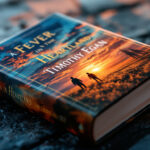Moby-Dick by Herman Melville – A Fresh Look at a Timeless Classic
Few novels manage to blend adventure, philosophy, and history quite like Moby-Dick by Herman Melville. Published in 1851, this iconic work goes far beyond the tale of Captain Ahab’s obsession with a whale. It’s a detailed look at human ambition, the power of nature, and the complexities of 19th-century seafaring life. Whether you’re a seasoned reader or just dipping into American classics, Moby-Dick remains incredibly relevant for its reflections on human nature and its rich layers of storytelling.
Overview of Moby-Dick
Herman Melville’s Moby-Dick dives deep into the human experience, blending gripping storytelling with philosophical undertones. At its core, the novel is a narrative of vengeance, obsession, and the relentless pursuit of the unattainable. Let’s explore this literary masterpiece through two key lenses.
The Central Plot
Moby-Dick unfolds through the eyes of Ishmael, a contemplative and somewhat restless narrator. Yearning for adventure, Ishmael joins the whaling ship Pequod, captained by the enigmatic and brooding Ahab. At first, the voyage seems straightforward, promising hard work and camaraderie among the crew. However, it soon becomes clear that Ahab harbors a deeply personal mission. The captain is consumed by his thirst for revenge against Moby Dick, a colossal white whale that once maimed him by severing his leg.
Through Ishmael’s observations, we witness the escalating tension aboard the Pequod. Ahab’s fixation on Moby Dick takes on an almost mythological quality. The whale becomes more than just an animal—it embodies Ahab’s internal demons and his battle against a greater, inexplicable force. The crew, bound by duty and fear, becomes unwilling participants in Ahab’s obsessive pursuit. This quest unfolds in gripping detail and reaches its ominous climax when the crew finally faces the legendary whale.
For a broader breakdown of the novel’s storyline, you can explore this summary of Moby-Dick or this detailed plot analysis, which dive deeper into the intricacies of Ishmael’s narrative and the themes of the novel.
The World of Whaling
Melville’s novel is not just about revenge—it’s also a richly detailed account of 19th-century whaling practices. Whaling during this era was a cornerstone of many economies, providing whale oil, which was essential for lighting lamps and lubricating machinery. The Pequod serves as a microcosm of this industry, showcasing the demanding, often perilous lives of those aboard whaling ships.
The whaling process described in Moby-Dick is precise and vivid, from the harpooning of whales to the rendering of oil. Melville doesn’t shy away from the grittier details, offering readers an authentic picture of the trade. Beyond its economic importance, whaling also held cultural significance, symbolizing humanity’s struggle against nature’s vast and uncontrollable forces. In Melville’s hands, the industry becomes both a backdrop and a metaphor for human ambition and mortality.
For a closer historical perspective on 19th-century whaling, check out this history of the whaling industry or dive into the old-school methods of whaling that informed much of Melville’s descriptive writing.
This blend of personal drama and historical detail gives Moby-Dick a sense of timeless relevance, offering readers both a thrilling story and a meticulous look at a bygone era. If you’re ready to immerse yourself in its pages, the novel’s layers will unfold like waves crashing against the Pequod.
Themes and Symbolism
Herman Melville’s Moby-Dick is a layered tale, rich in themes and symbolic undertones. The novel goes beyond the physical journey of its characters, exploring universal questions about human nature, the mysteries of existence, and our place in the natural world. Let’s dive into three key themes to uncover the depth of Melville’s masterpiece.
Obsession and Madness
Captain Ahab is the embodiment of obsession. His relentless pursuit of Moby Dick, the white whale, is not just a quest for vengeance—it’s an all-consuming mania. Ahab views the whale as the root of all evil and his personal nemesis. This singular focus isolates him from his crew and blinds him to the potential consequences of his actions.
This theme reflects how unchecked obsession can spiral into madness. Ahab’s behavior serves as a cautionary tale, illustrating the destructive power of placing personal vendettas above the well-being of those around us. Through Ahab, Melville explores how obsession can distort perception and lead to self-destruction. For a deeper look at Ahab’s character and his tragic flaws, check out this comprehensive character analysis of Captain Ahab.
Man vs. Nature
The conflict between man and nature is one of the central threads in Moby-Dick. On one hand, the crew of the Pequod represents human ambition to conquer and exploit nature. On the other hand, Moby Dick symbolizes the immense, untamed forces of the natural world. This battle is unequal, with nature remaining indifferent to human struggles and desires.
Melville doesn’t portray nature as malicious but rather as an unpredictable power that resists being tamed or understood. This theme resonates today, as we continue to grapple with the limits of our control over the environment. The novel’s depiction of this struggle reminds us of the delicate balance between humanity and the natural world. Dive deeper into this theme through this insightful analysis of man and nature in Moby-Dick.
Philosophical Reflections
Much of Moby-Dick’s philosophical depth comes from Ishmael, who serves as both narrator and a reflective observer. Through Ishmael, Melville delves into questions about religion, existence, and the human condition. His thoughts often read like meditations, offering a counterpoint to Ahab’s obsessive drive. Ishmael ponders humanity’s limited understanding of the universe, whether it’s the inscrutable nature of the whale or the broader mysteries of life.
Ishmael’s reflections encourage readers to question their preconceived notions and embrace a more open, inquisitive mindset. He represents a voice of reason and contemplation, cutting through the chaos that defines much of the novel. To explore Ishmael’s philosophical layers, visit this fascinating analysis of Ishmael’s perspectives in Moby Dick.
These themes underscore Melville’s ability to weave complex ideas into an adventurous narrative. Each layer of Moby-Dick reveals a deeper understanding of human ambition, frailty, and the interconnected forces that shape our world. Readers are invited to reflect on their own struggles and beliefs through the lens of this timeless classic.
Notable Characters
The characters in Herman Melville’s Moby-Dick are unforgettable, each contributing uniquely to the depth of the story. From the introspective narrator Ishmael to the enigmatic significance of Queequeg and the tragic intensity of Captain Ahab, every character plays an integral role in shaping the narrative. Here’s a closer look at some of the key figures.
Ishmael: The Observer
Ishmael is the voice of Moby-Dick, recounting the events aboard the Pequod with a mix of curiosity and reflection. As an outsider to the close-knit world of whaling, Ishmael is our guide, offering a thoughtful, sometimes philosophical perspective. His storytelling blends factual accounts of whaling with introspective musings that provide deeper meaning to the story.
What makes Ishmael unique is his ability to weave between detached observation and emotional participation. He invites the reader to see the world through his eyes, questioning everything from the brutality of whaling to humanity’s struggle against nature. This critical balance between emotion and logic cements Ishmael as one of the most relatable and enduring narrators in literature.
For an in-depth look at Ishmael’s role, visit the Moby-Dick character list, which provides a detailed breakdown of his significance.
Queequeg: The Harpooner
Queequeg is more than just a harpooner—he’s a cultural bridge in a time when such connections were rare. Despite his background as a cannibalistic islander, Queequeg is portrayed with dignity, intelligence, and a sense of humor. His immediate friendship with Ishmael underscores the theme of unity amid diversity, a central message of the novel.
Queequeg’s skills and bravery are indispensable to the Pequod’s operations, but his character is much more than his whaling talents. His confidence and unique worldview challenge the prejudices of his time, making him an exceptionally progressive figure for 19th-century fiction. His bond with Ishmael also sets a tone of camaraderie and mutual respect before the more chaotic events of the story unfold.
To explore Queequeg’s importance in the novel, check out this analysis of Moby-Dick characters for more insights.
Captain Ahab: The Tragic Hero
Captain Ahab dominates the narrative of Moby-Dick with his towering presence and singular obsession. His quest for revenge against the white whale, Moby Dick, becomes an all-consuming force, driving the Pequod and its crew into dangerous waters—both literally and figuratively. Ahab is not merely a villain; he’s a tragic hero, defined as much by his charisma and leadership as by his flaws.
Ahab’s complexity lies in his ability to inspire loyalty, even as his obsession verges on madness. He views the whale as the physical incarnation of an inscrutable cosmic force, something that must be confronted at any cost. This arrogance and refusal to accept nature’s supremacy serve as cautionary elements of his character. Ahab is not just fighting a whale—he’s battling his demons and challenging the universe itself.
Dive deeper into the tragedy of Captain Ahab through this character analysis of Ahab, which explores his motivations and psyche.
These characters provide rich emotional and intellectual layers to Moby-Dick, transforming it from a simple tale of revenge into a profound exploration of life, obsession, and humanity’s place in the natural world.
Writing Style and Structure
Herman Melville’s Moby-Dick stands out for its unique approach to storytelling, blending symbolism, inventive narrative techniques, and diverse literary formats. The novel mixes thrilling narrative moments with philosophical digressions and encyclopedic details about whaling. This multifaceted approach is what makes Moby-Dick a complex, yet rewarding read. Let’s explore two key aspects of Melville’s style and structure in depth.
The Use of Symbolism
Symbolism is a cornerstone of Melville’s writing in Moby-Dick. Among the most iconic symbols is the White Whale itself, representing far more than an ordinary animal. For Captain Ahab, Moby Dick is no mere creature but rather the embodiment of everything mystifying and uncontrollable in life. Ahab’s vendetta against the whale becomes a symbolic struggle against fate, the unknown, and even God itself. This layered meaning is what elevates the whale to near-mythical status.
The sea, too, is more than just the setting of the novel. It mirrors the vast, unknowable expanse of human existence. It is both a provider and destroyer, often reflecting the mood of the Pequod’s crew. The sea constantly contrasts Ahab’s obsessive precision with its own chaotic, unpredictable nature.
Melville doesn’t stop there—objects, characters, and even colors are rich with meaning. For example, the whiteness of the whale has been analyzed as a symbol of purity, fear, the sublime, or even the void itself. If you’d like to dive deeper into how the white whale serves as a multifaceted symbol, visit this excellent analysis of the White Whale in Moby-Dick.
The Narrative Voice
Ishmael, the novel’s narrator, brings an unusual perspective that shapes the story profoundly. Starting with the famous line, “Call me Ishmael,” he immediately establishes himself as a humble observer. Unlike traditional narrators, Ishmael often steps back from the main narrative to offer philosophical musings or provide factual insights about whaling. His voice is both intimate and encyclopedic, making the reader feel like a trusted confidant while also expanding their understanding of the world.
One of Ishmael’s greatest strengths as a narrator is his curiosity. His digressions—whether into the anatomy of whales or the history of shipwrecks—enrich the narrative’s layers. These explorations might at first seem like a distraction, but they ultimately reinforce the novel’s broader themes of interconnectedness and the quest for understanding.
Ishmael’s narrative voice also blurs the line between Melville’s own thoughts and his fictional storytelling. This fusion draws readers into Ishmael’s internal world, full of discovery and awe. However, his perspective is not without bias, as his worldview is often shaped by his personal experiences and limitations. To explore how Ishmael’s narration defines Moby-Dick, check out this essay on shifts in narrative voice.
Through his use of symbolism and inventive narrative voice, Melville crafts a story that feels as monumental and enigmatic as the White Whale itself.
Legacy and Reception
Moby-Dick by Herman Melville is a literary enigma that has traveled a fascinating journey from obscurity to legendary status. Its path has mirrored the unpredictability of the whale it portrays, diving in and out of cultural relevance over time. To better understand how this novel made its mark, let’s examine its reception over the decades, its modern interpretations, and its undeniable influence on popular culture.
Early Reviews and Popularity
When Moby-Dick was first published in 1851, it was not the cherished classic we know today. On the contrary, early reviews were blunt and often scathing. Critics found its ambitious mix of adventure, philosophy, and whaling minutia to be confusing, and it left many wondering what to make of this sprawling narrative. Some reviewers praised its originality, but others dismissed the novel as overly verbose and unfocused. For instance, this roundup of original 1851 reviews reveals how polarizing Melville’s magnum opus initially was.
Commercially, the novel was a flop. It sold fewer than 3,000 copies during Melville’s lifetime, leading some to label it a failure. This lack of success weighed heavily on Melville, effectively ending his career as a novelist. However, opinions began to shift in the early 20th century. Rediscovered by literary critics and scholars, Moby-Dick was reevaluated as a masterpiece of American literature. By the mid-1900s, it had firmly cemented its place as a cornerstone of the literary canon. More about its initial rise can be found in this insightful analysis on how Moby-Dick transitioned from failure to fame.
Modern Interpretations
Today’s readers often approach Moby-Dick through its rich themes, complex characters, and multi-layered storytelling. It’s no longer just a tale of revenge or an account of whaling. Modern interpretations emphasize its relevance to contemporary issues like environmentalism, morality, and the human relationship with nature. Captain Ahab’s obsessive pursuit of Moby Dick is frequently seen as a reflection of personal and societal hubris—a timeless warning about the dangers of unchecked ambition.
Queer theory and postcolonial perspectives have also greatly influenced modern readings of the novel. Ishmael’s close bond with Queequeg, for example, has been interpreted as a representation of interracial and same-sex relationships, challenging 19th-century social norms. Critics have also highlighted how the novel subverts traditional narratives by giving voice to diverse characters and marginalized communities. As explained in this article from The Guardian, it’s a story that remains “terrifyingly relevant” in addressing themes of ambition, identity, and survival.
Influence on Popular Culture
The mark of Moby-Dick on popular culture is hard to overstate. It has inspired countless works across mediums, from literature and music to film and television. Herman Melville’s iconic creation has become shorthand for obsession, resilience, and confrontation with the unknown.
In music, Moby-Dick inspired Led Zeppelin’s 1969 track, “Moby Dick,” a drum-driven instrumental showcasing immense power and persistence—much like the novel itself. In film, the novel has spurred adaptations ranging from John Huston’s 1956 movie starring Gregory Peck to modern reimaginings featuring settings as diverse as space and dystopian realities.
The book has also been a frequent reference in TV shows like The Simpsons and Star Trek, not to mention its cultural influence on brands such as Starbucks, whose logo nods to the nautical themes of Melville’s universe. For more examples, check out Moby-Dick in popular culture for a list of notable references across entertainment and art.
Melville’s tale proves that even if a book begins as a misunderstood underdog, its themes and messages can resonate for generations. Whether it’s through Ahab’s unyielding quest, Ishmael’s introspective storytelling, or the mysterious power of the White Whale, Moby-Dick continues to provide fertile ground for creative and intellectual exploration.
Conclusion
Moby-Dick stands as an enduring exploration of humanity—our ambitions, flaws, and connections to forces beyond our control. Its universal themes of obsession, resilience, and the search for meaning resonate as much now as they did in 1851. Whether you see it as a tale of revenge or a meditation on existence, its layers ensure every reader uncovers something new.
Melville’s masterpiece is more than a book; it’s an experience that challenges and rewards in equal measure. If you haven’t yet set sail with Ishmael and the Pequod, now might be the perfect time to dive in. What lessons will you find in its depths? Let us know your thoughts on this timeless classic!







